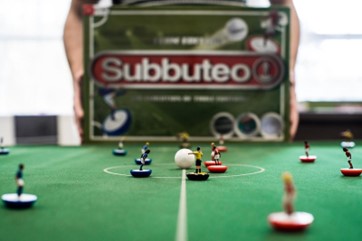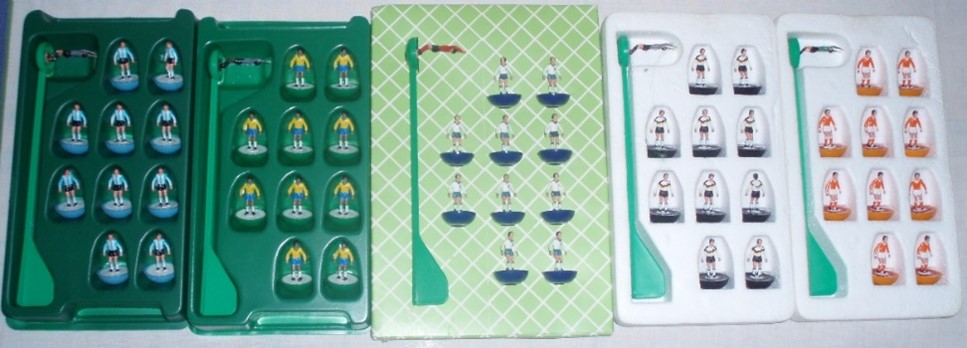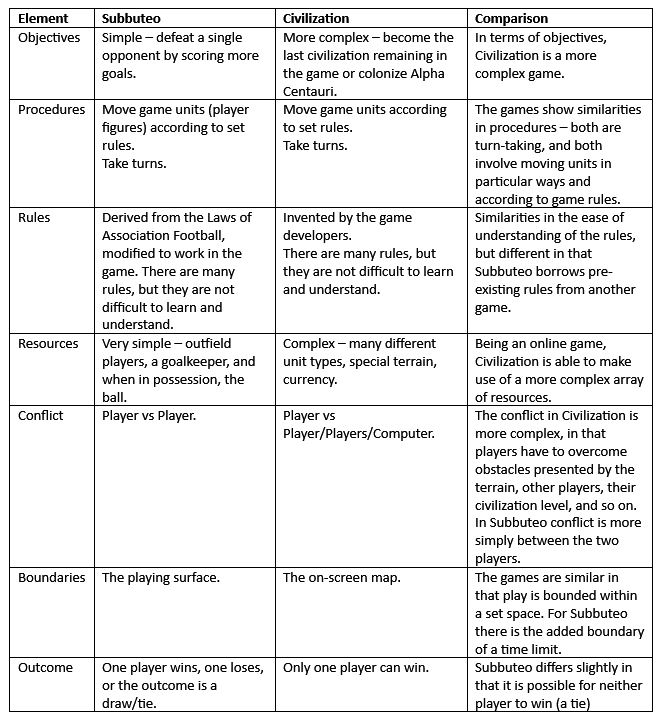2. Exercise 2.1: Think of a Game
- Think of a game, any game. Now write down a description of the game. Be detailed. Describe it as if to someone who has never played a game like it before.
- Now think of another game – a completely different type of game. The more different this game is from the first one, the better. Describe it.
- Compare your descriptions. Which elements were different, and which were similar? Dig deep and really think about the underlying mechanics of each game.
Subbuteo
Subbuteo is a table-top soccer game for two players. In terms of player interaction patterns (Fullerton, 2019, pp. 59-60) Subbuteo is a player vs. player game. The equipment to play can vary, but in its most basic form it comprises a soccer pitch (made of cloth and usually mounted on a hard surface like a tabletop or permanently fixed to a board), two teams of 10 outfield players and one goalkeeper each, two goals, and one or more soccer balls.

The players are around 3cm high and made of molded plastic. Players have rounded plastic bases. The goalkeepers are mounted on the end of a longer plastic arm so that they can be inserted through the goal and controlled from behind the goal by the players.

Objectives (Fullerton, 2019, pp. 68-73)
The objective of the game is similar to real-life soccer: score more goals than your opponent within an agreed-upon time, divided into two equal halves.
Procedures (Fullerton, 2019, pp. 74-76)
- To start the game the ball is placed in the middle of the centre circle on the pitch. Players can arrange their outfield pieces in any arrangement they choose, although most people choose to use one of the common formations used in real soccer, for example 4 defensive players, three midfielders and three attackers (the so-called 4:3:3 formation). A coin is tossed to determine who will kick off first. The other player kicks off the second half of the game.
- Players move their outfield men (happily there are women’s teams version of Subbuteo available now, but for simplicity I will use the term ‘men’ to refer to the playing figures for this description) by flicking them with the nail of the index or middle finger. Using the thumb as a ‘spring’ is prohibited.
- From the kickoff, the player in possession of the ball flicks one of his men toward the ball. If he makes contact with the ball, he retains possession.
- If he misses the ball, the other player assumes possession. The same man can ‘play’ the ball a maximum of three times in succession, after which another man needs to play the ball.
- For each flick by the player in possession, the defending player has a matching ‘defensive’ flick where he/she can move one of their men into a new position. This man cannot touch the ball.
- If the ball is within the shooting zone indicated on the pitch (a line across the width of the pitch set between the halfway line and the goal line), the player is allowed to take a shot on goal. The defending player may use their goalkeeper to try and stop the shot.
- The game ends when the previously agreed time limit is reached. This is commonly 15 minutes per half but can vary by agreement between the players beforehand.
Rules (Fullerton, 2019, pp. 76-80)
- The game follows closely the Laws of Association Football (soccer), and many of the Subbuteo rules match the Laws of soccer:
- If the ball goes out of play on the side lines, the other team is awarded a throw-in (i.e., they can place the ball on the sideline and bring a man across to flick/kick the ball back into play).
- If the ball goes out of play across the goal line and was last played by the attaching team, a goal-kick is awarded and the defending team assumes possession, taking a man from anywhere on the pitch to take the kick from within their own penalty box. If the ball hits a defender before going out of play over the goal line, a corner kick is awarded to the attacking team.
- If a man makes contact with a man from the opposing team before hitting the ball (or if a defensive flick hits an opposing man) this is deemed a foul, and the other team is awarded a free kick. If the ball strikes a man who has fallen over and not been righted by the controlling player, this is deemed a handball foul. If the foul occurs in the penalty area, a penalty kick is awarded.
- If a goal is scored, the game restarts with the ball in the centre circle and the team that conceded the goal in possession. Goals can only be scored If the ball started within the shooting zone. If a goal is scored from outside this zone, a free kick is awarded to the defending team, to be taken from the spot from whence the ball was kicked.
Resources (Fullerton, 2019, pp. 80-75)
- The main resources in the game are the playing figures. Some specialist figures are available for throw-ins and corner kicks, but these are optional. The goals, the ball, and the pitch itself make up the rest of the required resources.
Conflict (Fullerton, 2019, pp. 85-87)
- The conflict element of the game is self-evident – players compete against each other to score goals.
Boundaries (Fullerton, 2019, pp. 87-91)
- The action is bounded by the markings on the playing surface, and the game is also time-bound.
Outcome (Fullerton, 2019, pp. 91-92)
- The player whose team has scored the most goals is the winner. It is possible for a game to end in a draw/tie if both teams score the same number of goals. Subbuteo is a zero-sum game in that for one player to win the other must lose.
Civilization
Civilization is a computer game in which players assume the role of a leader of a civilization and compete against the computer and/or each other by building their civilization from nothing to a state of global domination.
Objectives (Fullerton, 2019, pp. 68-73)
The game has two alternative objectives:
- eliminating other civilizations, or
- colonizing Alpha Centauri.
It is also possible to play the game simply to enjoy the progression of your chosen civilization through the various milestones in the game.
Procedures (Fullerton, 2019, pp. 74-76)
- To start the game a player chooses (or is assigned) the role of leader of one of the in-built civilizations. In some version players can rename a civilization to one of their choosing.
- The game involves turns – for each turn a player either moves or manipulates a unit in other ways.
- Players move units around the playing area (a map of which only a small area is visible at the outset). Different units perform different tasks.
- As the units move around the map, more of the map becomes visible.
- If units encounter units or settlements from other civilizations, a range of options is offered, from attacking the unit/town to dialogue and negotiation.
Rules (Fullerton, 2019, pp. 76-80)
- Each player has one turn per unit per round in the game.
- For their turn they can create units, move units, give a unit orders, enhance an existing town, create a new town, and so on.
- The available actions vary from unit to unit. For example, only settler units can found a new town.
Resources (Fullerton, 2019, pp. 80-75)
The resources in the game consist of:
- Units that players can create and manipulate.
- Special terrain areas of the map (e.g. map squares that are available for mining).
- Currency – in-game currency can be earned and spent to speed up the creation of units or to make other enhancements to the civilization.
- Feedback – special advisers can provide hints and tips that players can choose to act upon or ignore.
Conflict (Fullerton, 2019, pp. 85-87)
- Conflict In the game is between rival civilizations, whether controlled by other players or by the computer. Conflicts generally arise over territory, or the desire to prevent a rival civilization from advancing through the stages.
Boundaries (Fullerton, 2019, pp. 87-91)
- The game action is bounded by the map, and individual units are restricted in the number of squares they can move in a given turn.
Outcome (Fullerton, 2019, pp. 91-92)
- The game continues until either only one civilization remains, or a civilization has advanced to the level where it can colonize other worlds (in this case the planetary system around Alpha Centauri).
A Comparison of Subbuteo and Civilization

Discussion
It is interesting to see how the formal elements of games (Fullerton, 2019, Chapter 3) appear in games as different as Subbuteo and Civilization. Likewise, the games exhibit similarities (each has a defined playing area, for example), while the greater affordances of the digital environment mean that Civilization expresses these basic elements in more complex ways. This is a convincing demonstration that these elements are common to most (if not all) games.
References
Fullerton, T., & Taylor & Francis eBooks EBA. (2019). Game design workshop: A playcentric approach to creating innovative games (Fourth ed.). Taylor & Francis, CRC Press.